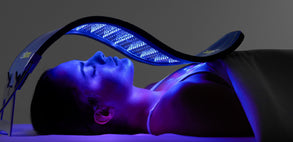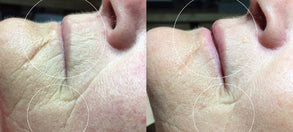Light therapy devices have exploded in popularity in just the last few years. A simple Amazon search will reveal a variety of devices of varying degrees of effectiveness. It’s important to know the difference between the facts proven by clinical research and marketing hype.
Myth #1: The more colors a device has the better it is.
In this case, more isn’t better! The device on Amazon with seven different colors is not better than a device with only one color or three colors. This is where it helps to understand what the most effective wavelengths (or colors) are, according to the science. There is NO credible research to support the therapeutic value of wavelengths other than blue, red, and near infrared. Blue, red, and near infrared wavelengths are supported by literally thousands of peer-reviewed clinical research studies to have significant therapeutic value when used correctly.
Blue, red, and near infrared wavelengths have been widely shown to increase ATP production in cells compromised due to aging, illness, disease, or just poor lifestyle choices. Blue light addresses acne issues, while red and near infrared decrease inflammation and increase microcirculation to bring more oxygen and nutrients to the area.
Myth #2: The more powerful a device is the better it is.
This is another misconception that more must mean better and it’s NOT true! Clinical research tells us what the correct therapeutic dose of light therapy should be. A biphasic dose response has been frequently observed where low levels of light have a much better effect on stimulating and repairing tissues than higher levels of light. The so-called Arndt-Schulz curve is frequently used to describe this biphasic dose response. What in the world does this mean? Well, this teaches us that a light energy dose of 2 – 10 joules per centimeter squared will trigger the up-regulation of ATP (what our cells need to function optimally). Delivering below 2 joules per centimeter squared is not enough to trigger ATP production, and more than 10 joules per centimeter square risks the triggering of toxic oxidative events.
Wow, that’s a lot to digest. Let’s break it down. What this means is that the amount of energy produced at the surface of an LED device is not relevant. What is relevant is the amount of light energy available for the skin to absorb at its surface. When absorbed in the correct dose (2-10 joules per square centimeter), close to the surface of the skin, light therapy promotes healthy aging, enhances wound healing, reduces pain, restores hair, improves acne, as well as other clinical benefits.
Myth #3: What about blue light? I’ve heard it can age my skin. Is that true?
NO, that is absolutely not true! The only value to using blue light is to kill acne causing bacteria. Blue wavelengths only reach into the superficial epidermal layers of the skin, so has no value for cells or conditions that reside in the dermal and subcutaneous layers of the skin. There’s a lot of fake news in the media about blue light being damaging and aging to the skin. Rest assured there is no scientific support for this blue light myth. As mentioned above, blue light is far too shallow reaching to affect any tissue or any cells beyond the epidermis, which is basically a layer of dead skin cells. Don’t believe the marketing hype!

Myth #4: A device that sells serums or masks is better than one that doesn’t.
Your skin is the most miraculous “bio-barrier ever designed. It’s meant to keep things out. Again, watch out for marketing hype! I’m sure you know that many companies are just trying to sell you additional products you DO NOT need! There are currently no rigorous clinical studies that prove there is a synergistic effect between LED treatment and serum penetration. The molecules in topically applied products are just too big to be “driven” deeper into the tissue. However, it is possible that these serums being sold by light therapy companies can block light penetration by 30% to 100%, curtailing the therapeutic benefit of light therapy treatments. When you consider that topical treatments are intended to affect only the first couple millimeters of the skin and light therapy penetrates as deep as 25mm below the surface of the skin, down into the subcutaneous tissue, why would you ever put something on the skin that would diminish the impact of the light therapy? You shouldn’t. It’s always best that light treatments be done on clear, dry, bare skin and the application of products should follow the light therapy treatment.
Myth #5: A device advertising a 5-minute treatment time is better than one that says you need 20 minutes or more.
Treatment time matters, too! It takes cells a certain amount of time to absorb enough energy to effect a change at the cellular level. The duration of the LED session should take this fact into account. High quality LED devices call for twenty to thirty-minute treatment times to deliver a full therapeutic dose (remember what we talked about it in Myth #2) of energy upregulating cellular activity for up to 48 hours post treatment. This is how a quality LED device achieves observable changes in skin, pain, hair, and wound conditions.
Now that you know the difference between the marketing hype and the true science of light therapy, you can learn a little bit more about the benefits of light therapy and how to choose the best device for yourself here: Five Things to Look For In a Red Light Therapy Device
Remember, knowledge is power. The more you know the truth, the more informed your purchasing decision will be.





